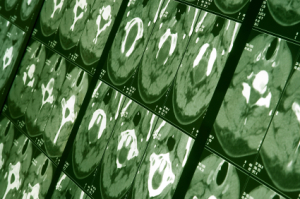ARRS 2010: Valkyrie "Rides" to Prevent CT Overexposure
by
Brendon Nafziger, DOTmed News Associate Editor | May 04, 2010

Calculating cumulative
dose exposure
Scientists in New York have created a computer system that automatically pulls radiation dosage off CT scan reports and alerts radiologists if dose levels exceed industry-standard values, a technology that could help patients better monitor their lifetime exposure as well as prevent the highly publicized dosage fiascoes that rocked the profession last year, a creator of the system said on Monday.
Dubbed the Valkyrie, the technology is a stand-alone server into which CT scanners feed reporting data. It then applies sophisticated algorithms that take into account the patient's weight and size, and the type of study performed, to generate the best reckoning of actual dose exposure. If the dosage exceeds average values determined by the industry, a warning is immediately sent to the radiologist.
"Before we developed this system, we had to manually do this quality control check. As you can imagine, it's pretty tedious and nearly impossible to do every study manually. This system automates being able to gather this type of data so we can promote better patient safety than we could before," Dr. George Shih, assistant professor of radiology at Weill Cornell Medical Center in Manhattan, and one of the system's designers, told DOTmed News.
CT scans can deliver 100 to 200 times the radiation dose of an X-ray, said Shih. And errors can be dangerous: In a case that made headlines across the country last year, a CT scanner at a hospital in Los Angeles exposed potentially hundreds of patients to up to eight times the recommended dose levels. [See DM 10525]
Eager to ensure patients at Cornell were safe, Shih, along with researchers at Cornell University's computer science department and colleagues across town at Columbia University, built Valkyrie as a way to automate the onerous quality control procedures, Shih said.
So far, the project appears to be working. Shih found that the Valkyrie was able to accurately and automatically capture radiation dosage from all 518 CT reports used in their most recent study, the results of which were presented Monday morning at the American Roentgen Ray Society (ARRS) 2010 Annual Meeting in San Diego, Calif.
"We did it for 518 initially, but we've had our system up and running for well over a month, so we have several thousand exams in real-time and we've done random sampling on them. It has all been 100 percent accurate," Shih said.
PATIENT SIZE
Shih hopes the Valkyrie will let patients develop a cumulative, lifetime dose chart to more accurately track their radiation exposure. For this to work, the system has to truly capture the real radiation dose, which is why the Valkyrie takes into account the patient's weight and size.
